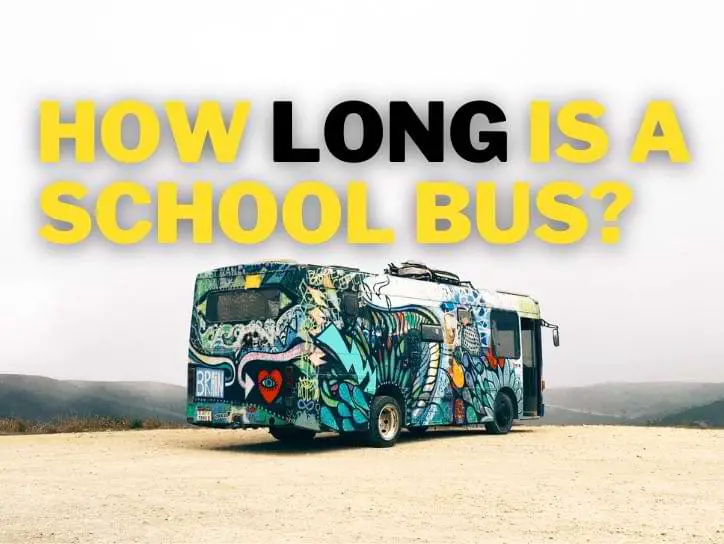For many of us living in today’s world, it is still a dream to call a place your own. Well, I can’t buy a home for you, but I can provide details about bus length, types and some design inspiration that will help you pick or convert a suitable bus into a remote home.
A School Bus comes in different dimensions, which is an important element in making a comfortable Skoolie. However, heavy vehicle manufacturers provide different essential options before making any final decision.
What Is The Average Length Of A School Bus?
An average School Bus length ranges from 20 (7.62 m) to 40 feet (12.19 m). Furthermore, a bus between 20-25 feet is known as mini or short. Another side, buses that measure between 25-35 feet are considered mid-size, and buses over 35 feet are full-sized.

| Bus Type | Length (Feet) | Length (Meter) | Length (Inch) |
|---|---|---|---|
| Mini or Short Bus | 20 to 25 | 6 to 7.6 | 240 to 300 |
| Mid-Size Bus | 25 to 35 | 7.3 to 10.6 | 300 to 420 |
| Full-Size Bus | Over 35 | Over 10.6 | Over 420 |
This article includes everything you wish to know dimensions of the School Buses.
What Is The Process For Measure Bus Sizes?
Any vehicle or School Bus is measured from end to end (front to rear bumper) to determine their total length so they can be easily classified under the required groups.
While the exterior and interior measurements are kept in mind, exterior measurement is generally taken to determine if you have that parking space, whereas interior measurements give you an idea of where to put which work.
In addition, the interior area of a bus excludes the engine and cockpit area while designing. The width of the buses is also taken into consideration, but often buses are 7.5 feet (2.29 m) wide, and the standard interior height is around 6 feet (1.83 m).
School Buses Types Based On Dimensions

1. Minibus
Minibuses are the smallest buses, measuring between 20 feet (6.1 m) to 25 feet (7.62 m). These buses are best for a nuclear family or a voyage with friends.
If you have more belongings, your bus can adjust by building shelves to store them. In addition, you can add features such as shower, toilet, and passenger seats. You can take your minibus for various errands as you won’t have to worry about its parking space.
Examples Of Vehicles Used For Minibus Conversions:
Fiat Ducato, Ford Transit, Freight Rover Sherpa, GAZelle, Hyundai H350, Iveco Daily, Mercedes-Benz Sprinter, Renault Master, Toyota Hiace, Volkswagen Crafter, Tata Winger & Force Traveller.
Average Specifications Of A Minibus:
| Engine | OM654 DE22LA |
| No of cylinders | 4 |
| Displacement | 1950 cc |
| Power | 114 hp |
| Torque | 300 Nm |
| Transmission | 9G-TRONIC |
| Fuel | Diesel |
| Drive | Rear-wheel drive |
2. Medium Size Bus
Medium-size buses are frequently measured between 25 feet (7.62 m) to 35 feet (10.67 m). These buses sit on the same chassis and come powered by the same engine as full-size buses, but in measurement, these are smaller and work well enough for a small family.
If you are taking your bus around the city, you might need to worry about parking as it requires more than one parking space.
3. Full-Size Bus
Buses measuring more than 35 feet (10.67 m) are considered full-size buses. These buses are best for those who don’t plan to be out a lot because parking-related things can be a headache often.
A full-size bus is best for family trips or trips with friends or colleagues if you can manage to find a parking space for it.
Types Of Bus Available For Skoolie Conversion

There are 3 types of buses you can use to convert into a Skoolie:
- School Bus: It is the market’s most popular and affordable option. A School Bus comes in different dimensions.
- Coach: Compared to a School Bus, a Coach is a bit wider and offers more storage space.
- Transit: This category offers retired city transportation buses in different lengths. Usually, it comes at a cheaper price.
What Are Different Ways To Estimate Bus Length?
If you go online, you can find several ideal kinds of schoolies, but would you know the measurements just by reading about them?
You can ask the agency or brand about the measurements, but the best way is to find it out by yourselves. Here I’ve listed a few general methods of estimation with which you can find the measurements just by the picture of the bus models.
1. Window Rule
Most buses have an interior length of 7.5 feet (2.29 meters) and windows measuring about 2.5 feet (0.76 meters). The estimated length depends upon the number of windows, as each window adds up to 2.5 feet (0.76 meters).
So, you need to count all the windows and multiply the number by 7.5 feet (2.29 meters) and then by 2.5 feet (0.76 meters), you will get the bus’s estimated length.
For example: If there are 5 windows, then the approximate square footage will be 5 × 7.5 × 2.5 = 93.75 square feet.
To find out the length, multiply the number of windows by the length of the window and then add the length of the bus/van front, likely around 10 feet (3.05 m). So, the length of the bus with all 5 windows would be 2.5 × 5 = 12.5 + 10 = 22.5 feet.
However, if the bus has a flat front, you will add a 6 in the equation instead of a 10 – (2.5 × 5 = 12.5 + 6 = 18.5 feet).
2. Length Estimation Of A Normal-Sized Bus
The length of a normal-sized bus depends on what kind of School Buses are available in your area. Generally, we can see buses from 40 feet (12.19 m) to 45 feet (13.72 m). In schools, buses are mostly large enough to carry 70 to 90 passengers at once. Depending on the bus style also, the measurement varies.
The capacity measured keeping passengers in mind:
- A bus with a capacity of 72 passengers is about 34 feet (10.36 m) long.
- A bus with a capacity of 84 passengers is about 39 feet (11.89 m) long.
- A bus with a capacity of 90 passengers is about 40 feet (12.19 m) long
Though the exact measurements depend on the body type, this is the approximate number. Like, for a wheelchair lift at the back of the bus, one foot of length is added.
3. Front End Style Estimation
As we have learned that front style is important for the length estimation of the bus. The general rule says to add 10 feet (3.05 m) for a van front or a dog nose or 6 feet (1.83 meters) if a flat nose to the number we get after multiplying the number of windows by 2.5.
Depending on the model, a bus’s front nose can carry an engine or storage compartment.
How To Choose The Ideal Bus Length To Convert Into Moving Home?

- Comfort level: If you are planning to live with your family, then you need to look for comfort. Some families can easily live in short spaces, while others need their privacy and space too. If your family comes in the latter group, then you have to look for enough space. If you have pets, it might require extra space for their bed and litter boxes. So, keeping all these things in mind, find the ideal bus for you.
- Purpose or lifestyle: You need to know your purpose for getting into a skoolie. If you are getting your skoolie for trips, then you will have to look for the parking space, and you would not be able to take the skoolie in some small town. You also cannot use the skoolie for your daily errands. On the other hand, if you are getting you just for dwelling, then you might look for all the sizes and choose one without so many worries.
- Parking space: You also need to check the space where you will convert your skoolie, if it is on the street, in your backyard or in some rented garage which might cost you a lot as it takes months to prepare a skoolie.
- Conversion cost: Before you start designing your Skoolie, Lastly, it’s you and your pocket who will have the final decision. Smaller buses are more expensive to buy than full-sized buses, but full-sized buses take up much space and cost more than the smaller buses while being converted. Maintaining a big bus is also more expensive than a small or a middle-sized bus as it requires more equipment and other pieces.
3 Best Place To Buy A Cheap School Bus

Depending on your budget and requirements, you can browse different online portals to see the latest listing. I’ve mentioned a few well-known brands to purchase a used bus. Let’s check them!
- eBay: Visit the online marketplace and end your search using different filters.
- Govdeals.com: This website is managed and operated by the government. You can browse/purchase different instruments and vehicles by directly contacting the owner.
- Busforsale.com: As the name suggests, you can check different bus categories & purchases.
3 Important Items To Consider During Skoolie Conversion
- Emergency Exits: Make sure that the position and number of emergency exits. Whether a mini or mid-size, your Skoolie must have an emergency exit opposite the service door.
- Family Safety: Whenever the bus passenger door or emergency Exit/door opens, the bus driver must get the same indication through a buzzer. The emergency doors shall be kept closed in normal condition.
- Entry: Skoolie entry ground clearance shouldn’t be lower than 300 mm. You should carry a folding or retracting step for easy access.
Conclusion
A full-sized or a normal skoolie might attract you with a full force to buy it, but I suggest you do not fall instantly for the pictures. This article is written to consider all the possible issues related to skoolies before, during and after buying them.
Go through your plans with a clear mind and then buy one, so the only thing you think about in future is your next trip.
FAQs
Which unit is best to measure the length of a School Bus?
A School Bus can be measured into feet, meters, and inches. As standard, industry measures by the meter.
How long is a type c School Bus?
A type c School Bus measures around 35 feet or 10.6 meters long.
How much time is required to convert a School Bus into skoolie?
On average, depending on the type of bus, a School Bus takes between 2 to 3 months in full conversion. This includes the body, interiors, electrical, plumbing and remaining items.
What is the cost to convert a School Bus into Skoolie or RV?
A School Bus conversion will cost you between $13 to 20k. This is just an idea before for a 22 feet bus, the actual cost after interiors can go up to $25.
What is the engine type in a School Bus?
Usually, a School Bus runs on a diesel engine because of its excellent fuel efficiency, high-torque, and long life.

